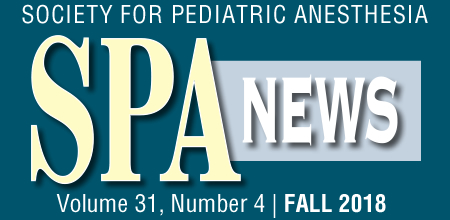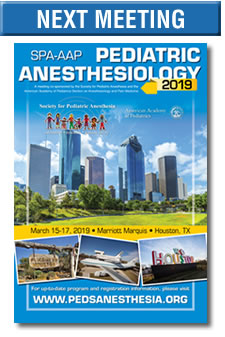meeting reviews
ASA Annual Meeting Session Reviews
Pediatric Acute Pain Management Workshop
By Franklin Chiao, MD, LAc
Assistant Professor of Anesthesiology
New York Presbyterian Medical Center
Weill Cornell Medical College
One of this year’s exciting workshops at the American Society of Anesthesiologists (ASA) Annual Meeting was the Pediatric Acute Pain Management workshop directed by Franklin Chiao MD and Karen Boretsky MD. The other faculty consisted of leaders from programs such as Boston Children’s Hospital, the Children’s Hospital of Philadelphia, Texas Children’s Hospital, Lurie Children’s Hospital, Seattle Children’s Hospital, and one faculty member came from as far as Italy. It started with a presentation describing recent research, new block techniques and review of block anatomy.
Recent research was presented. Pediatric pain resources are most plentiful in urban or academic centers whereas rural and community hospitals have fewer satisfactory services1. Most hospitals offer caudal blocks while peripheral nerve blocks are only provided at some hospitals. This gap in patient care provides opportunities and illustrates the need for education and improvement.
New techniques discussed included the pudendal nerve block. A review of the anatomy, and both landmark and ultrasound approaches were covered. Common surgeries where this block helps include circumcision, urethroplasty, scrotoplasty, orchiopexy, labialplasty, and other peno-scrotal procedures. Frequently, 0.2% ropivacaine or 0.25% bupivacaine at 0.2ml/ kg were used.
Participants then rotated at various stations covering upper extremity, lower extremity, truncal, neuraxial, paravertebral, erector spinae, and lumbar plexus blocks. Two stations were dedicated to multimodal PBLD discussions and acupuncture techniques. Each station had live block videos and analysis of ultrasound anatomy. New ultrasound devices and equipment for catheter infusions were available for participants to use. Caudal catheter equipment and methods were presented.
The faculty appreciate the support of the ASA and SPA members whose input and time made the workshop a success. Six children deserve recognition for kindly volunteering to be scanned.
- Chiao FB, Wang A. An Examination of Disparities in Pediatric Pain Management Centered on Socioeconomic Factors and Hospital Characteristics. J Racial Ethn Heal Disparities. February 2017:1-5. doi:10.1007/s40615-017-0343-3.
Updates in Infant Neuraxial Anesthesia: Caudal Catheters, Spinal Without General Anesthesia, and Other Clinical Pearls
This lecture at the American Society of Anesthesiologists (ASA) Annual Meeting covered infant neuraxial anesthesia. It was organized by Karen Boretsky, MD; Franklin Chiao, MD; and Giorgio Ivani, MD. The following three major areas were covered. First, the risks and benefits of different techniques for placing caudal epidural catheters were examined. Then, new developments in spinal anesthesia were discussed. These innovations make its performance without general anesthesia easier. Lastly, controversies in pediatric regional anesthesia were discussed.
The first part of the lecture covered spinal anesthesia. A flowchart describing challenges to starting a pediatric spinal anesthesia program was presented. In general anesthesia cases, everyone has similar expectations and plans to do an inhalational mask induction, place an intravenous catheter and intubate. Spinal anesthesia administration on the other hand has more variation in technique. Some people put the IV catheter in before the spinal while others place it after. Some swaddle the arms, while others tape them at the side. Some use sedation or pacifiers and others do not. Reaching a consensus with your anesthesia team about a routine is one big step towards making spinal anesthesia more palatable and efficient for surgeons, nurses and staff.
Three cases were covered highlighting clinical pearls of spinal anesthesia. One advantage is the natural airway for premature babies. Another advantage is the opportunity to avoid general anesthesia if this is a concern especially given recent publications about neurotoxicity. In addition, the latest neurophysiology research showed alterations in cerebral oxygenation after spinal anesthesia are minimal. In a recent paper, 103 infants were examined and no significant change in oxygenation was noted. Cerebral autoregulation appears to be intact after spinal anesthesia.
Dr. Chiao spoke about publications highlighting the effective use of spinal anesthesia block with natural airway for laparoscopic surgery. These patients were given dexmedetomidine as supplemental IV sedation. No complications occurred and surgeries were completed sufficiently. In some cases, no opioids were given, and pain scores remained low throughout the hospital stay. He also discussed the controversy about age as a relative contraindication for spinal in children. He has performed spinal anesthesia on patients of all ages. He then discussed sedation doses, neuraxial ultrasound and went through sample spinal enhanced recover after surgery (ERAS) algorithms.
The next section of the lecture covered caudal and epidural anesthesia. Dr. Chiao discussed the lower percentage of complications occurring with peripheral nerve blocks compared to central blocks in children. However, the central nerve blockade complication rate is still very low. The percentage of peripheral nerve catheters use has also grown the last decade.
Images and videos of caudal catheter placement techniques were illustrated. Electrostimulation is a great technique, but kinking of the catheter can still occur. X-ray is another excellent technique, but the child is exposed to radiation. Ultrasound is a very effective technique, but as the infant ages, the catheter cannot be seen in the epidural space, so real-time ultrasound of the catheter cannot be visualized. Furthermore, the advantages of 2-chloroprocaine epidural infusions was discussed. With its short half-life, it is ideal for prolonged neonatal and infant epidural infusions.
Lastly, areas of controversy were discussed. Dr. Ivani discussed the weak evidence for and against neuraxial test doses with epinephrine. Local anesthetics themselves are a test dose. Next, he noted that loss of resistance to air mixed with saline is a good option for epidural placement. In theory, the injection of air into the epidural space is dangerous, but with a careful technique the amount of air that gets pushed in is too low for major concerns. He also discussed the safety of caudal blocks and noted that he does not routinely use ultrasound for placement.






